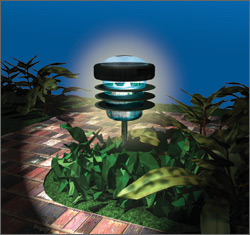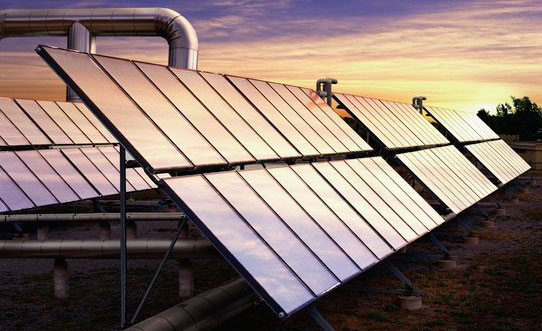 Up to now it has been generally assumed that global warming will be a linear process. However evidence from the geological past linked with climate modelling that takes into account the global warming that is already locked into the system indicates that there may not be a linear response to rising CO2 levels. There is a danger that at some point we will cross a threshhold when global warming accelerates. By continuing to increase the amount of CO2 in the atmosphere we are getting closer to that point.
Up to now it has been generally assumed that global warming will be a linear process. However evidence from the geological past linked with climate modelling that takes into account the global warming that is already locked into the system indicates that there may not be a linear response to rising CO2 levels. There is a danger that at some point we will cross a threshhold when global warming accelerates. By continuing to increase the amount of CO2 in the atmosphere we are getting closer to that point.From the analysis of the bubbles of air trapped in ice cores taken from the Greenland icecap that are up to 500,000 years old it has been shown that the temperature of the Earth's atmosphere and the CO2 content has followed a regular 100,000 year cycle of change with the CO2 content and temperature closely linked and following the same graph line. Within this regular cycle there are some recently discovered very short periods of approximately only a few hundred years duration when temperatures rise dramatically by 8 degrees centigrade above the slower rises of up to 7 degrees centigrade. This gives a total range of 15 degrees centigrade from peak to trough. These records show natural processes at work before the impact of man's activities. We are currently in the lower temperature part of the cycle.
During the period covered by the ice core research the CO2 content of the atmosphere has varied between 170 and 280 ppm. (parts per million). From 1850 to today with the added input from the burning of fossil fuels the CO2 content has risen to 350 ppm. So we are now well outside of the historic range of values and CO2 levels are going to continue to rise for a long time yet and temperatures will follow.
Recent research has shown that the Amazon rain forest is not a stable mature forest with growth and decay in balance but is in fact an expanding forest that is being fertilised by the excess atmospheric CO2. The trees are getting bigger and there is a net take up of 5000 kg of carbon per hectare per year (1 hectare = 100 x 100 metres). The total area of forest is 400 million hectares so the whole forest could be absorbing 2 billion tons of carbon per year.
Research in the savanah lands to the east of the Amazon Basin has established that the crucial factor determining the development of the rain forest is the length of the dry season. The savanah to the east of the Amazon Basin and the eastern Amazon rain forest both receive about the same amount of rainfall, 1500 mm per year. However in the savanah the dry season lasts 6 months but in the rainforest the dry season only lasts 4 months.
As a result of the longer dry season the savanah catches fire an average of twice in ten years whereas the rainforest with the shorter dry season does not dry out and remains damp enough to prevent fire. In the savanah the fires destroy most of the vegetation and this prevents the savanah developing into a rainforest. If the dry season in the rainforest was extended to 6 months by climate change effects then the rainforest would dry out and burn and could not then re-establish itself. If the rainforest burnt this would release the CO2 currently being absorbed year by year. So the forest would change from being a buffer which for a hundred years has absorbed our excess CO2 into a major source of CO2 releasing tens of years build up of CO2 in a matter of weeks.
It is accepted by all, including climate change sceptics, that increasing the amount of CO2 in the atmosphere will lead to increased global warming and many computer models have been constructed giving a rise in average atmospheric temperature of between 2 and 6 degrees centigrade by the end of the century i.e. by 2100.
But only now are models being constructed that incorporate a feed-back into the model of the effects of changes in world climate due to the changes in temperature that are predicted by the model as the model programme runs. One of the most important effects of climate change is the release of carbon dioxide from natural processes as atmospheric temperature rises.
Because of the "above normal" level of CO2 already in the atmosphere we are already committed to a certain amount of global warming because the excess CO2 will remain effective for many years. In addition the continued burning of fossil fuels will continue to add to the atmospheric burden of CO2. This warming will inevitably cause some climate change.
The area of the world most vulnerable to the effects of global warming induced climate change is the Amazon basin. The climate change models show that rising sea temperatures in the Pacific Ocean result in less rainfall and a longer dry season in the Amazon Basin. As described above this could lead to a reversal of the Amazon basin acting as a CO2 sink and it becoming a major source of CO2 returning the billions of tons of carbon to the atmosphere that have been stored there.
If the Amazon rainforest burns and releases billions of tons of CO2 into the atmosphere in a short period then this will be a further boost to global warming that will result in significantly higher end of century temperatures.
The climate change model with climate change induced feedbacks indicates that on present trends the date for the change from CO2 sink to source for the Amazon rainforest is about 2050. So we have not got much time to get CO2 under control before that might happen. The Amazon rainforest is at present still acting as a buffer and is protecting us from the full effect of the global warming that would be created if all the CO2 we produce remained in the atmosphere.
If temperatures rise too high then there could be another natural phenomenon which would lead to the release of methane into the atmosphere. Methane is a very powerful greenhouse gas
Current research based on the analysis of ancient sediments from Vladivostock and fossil evidence from Wyoming indicates that runaway methane global warming events have occurred in the past and the conditions prevailing on Earth now are suitable for it to happen again.
 Hybrid cars are great and have a lot of advantages, no doubt about it. Hybrid cars save you gas, therefore keeping your wallet thick! These cars also have less contribution to the greenhouse effect than conventional cars. These are the two biggest pros of a hybrid car. But we all know if something has advantages, it has disadvantages too!
Hybrid cars are great and have a lot of advantages, no doubt about it. Hybrid cars save you gas, therefore keeping your wallet thick! These cars also have less contribution to the greenhouse effect than conventional cars. These are the two biggest pros of a hybrid car. But we all know if something has advantages, it has disadvantages too! Ever since 2005, the IRS has been giving a tax credit to individual taxpayers who drive cars which use alternative fuel sources. There was at one time just a clean fuel burning deduction available to green minded taxpayers, but this only applied to gas-electric hybrid vehicles. In 2005, however, this was replaced by the current legislation, the Energy Policy Act. By the terms of this 2005 law, the tax credit is taken directly from the total amount of tax which the taxpayer would otherwise owe. This reduces or can even eliminate the tax which the individual in question must pay. If you are unsure whether or not your particular "green" vehicle qualifies for this credit, you can ask your car manufacturer or your local dealership.
Ever since 2005, the IRS has been giving a tax credit to individual taxpayers who drive cars which use alternative fuel sources. There was at one time just a clean fuel burning deduction available to green minded taxpayers, but this only applied to gas-electric hybrid vehicles. In 2005, however, this was replaced by the current legislation, the Energy Policy Act. By the terms of this 2005 law, the tax credit is taken directly from the total amount of tax which the taxpayer would otherwise owe. This reduces or can even eliminate the tax which the individual in question must pay. If you are unsure whether or not your particular "green" vehicle qualifies for this credit, you can ask your car manufacturer or your local dealership. Do you care about the environment and your health, but want to be stylish with your home décor at the same time? Luckily, there are plenty of green living options that can be implemented in your home in order to create a great look while remaining eco-friendly.
Do you care about the environment and your health, but want to be stylish with your home décor at the same time? Luckily, there are plenty of green living options that can be implemented in your home in order to create a great look while remaining eco-friendly.  If you are serious about saving money by going green then you seriously need to consider making your own green energy source. It's cheap, easy, and efficient. Did I mention that it can also help you save hundreds of dollars every month on your energy bill? Yes, that's correct by making your own source of green energy you will no longer have to rely on your utility company for energy. This means that you can say goodbye to the rising costs of energy and hello to a new world of savings.
If you are serious about saving money by going green then you seriously need to consider making your own green energy source. It's cheap, easy, and efficient. Did I mention that it can also help you save hundreds of dollars every month on your energy bill? Yes, that's correct by making your own source of green energy you will no longer have to rely on your utility company for energy. This means that you can say goodbye to the rising costs of energy and hello to a new world of savings. Although filling our tires with air may help save on gas, it doesn't help with the higher prices of food, clothing, and other necessities. It used to be quite expensive to do things "green" - for instance spending your whole paycheck at Whole Foods to buy eco-friendly household products and organic food. However, now there are alternatives to spending a fortune on eco-friendly products, and not only does it save you money, it's also chic to "go green".
Although filling our tires with air may help save on gas, it doesn't help with the higher prices of food, clothing, and other necessities. It used to be quite expensive to do things "green" - for instance spending your whole paycheck at Whole Foods to buy eco-friendly household products and organic food. However, now there are alternatives to spending a fortune on eco-friendly products, and not only does it save you money, it's also chic to "go green".





